Using Silane Coupling Agent Coating on Acidic Aggregate Surfaces to Enhance the Adhesion between Asphalt and Aggregate: A Molecular Dynamics Simulation
Abstract
1. Introduction
2. Materials and Methodology
2.1. Raw Materials
2.2. Granite Aggregate Surface Treatment
- Hydrolysis process of KH560: The mixed solution was prepared by mixing KH-560, distilled water, and ethanol at a ratio of 1:4:6 by mass for 6 h in a water bath at 60 °C. In what follows, the hydrolysis process of KH560 occurred at a normal temperature for 30 min to obtain a KH-560 hydrolysis solution.
- Get clean and dry granite: The granite aggregates were obtained by sieving, followed by the water wash and drying. Aggregates with a particle size from 13.2 to 19 mm were used in the boiling test, and aggregates with particle size under 13.2 mm were used to prepare asphalt mixtures.
- SCA modified granite surface: Granite aggregates were immersed in the prepared KH-560 hydrolysates solution for 5 min, and then the granites were placed in an air-dry oven pre-heated at 60 °C for one hour. Subsequently, the aggregates were heated at 170 °C with a curing time of one hour. Finally, the modified granite samples were cooled down at room temperature for the adhesion test.
2.3. Aggregate Wrapped by Asphalt
2.4. Preparation of the Asphalt Mixture
2.5. Boiled Experiment
2.6. Tests for Asphalt Mixtures
3. Molecular Dynamics Simulation
3.1. Asphalt Model
3.2. Molecule Models for Aggregate-Asphalt
3.3. Interpretation of Simulation Results
3.3.1. Radial Distribution Function
3.3.2. Concentration Distribution of Asphalt Binder Components
3.3.3. Interfacial Adhesion Energy
4. Results and Discussion
4.1. Effect of SCA on Adhesion between Granite Aggregate and Asphalt
4.2. Effect of SCA on Residual Stability of Marshall Tests
4.3. Effect of STA on Granite Mixture Freeze-Thaw Splitting Test
4.4. Intermolecular Distribution-Radial Distribution Functions (RDF)
4.5. Distribution Characteristics of Asphalt Binder Components
4.6. Effect of SCA on Adhesion of the Asphalt-Aggregate System
5. Conclusions
- The SCA of KH-560 can significantly improve the adhesion between acid aggregate and asphalt. Through the boiling test, the adhesion of asphalt and aggregate obeys the order: GA < BA < LA < GAK.
- The immersion Marshall and freeze-thaw split test results showed that the asphalt mixture incorporating the SCA aggregates could significantly improve the low-temperature performance. Moreover, they had stronger water damage resistance and aging resistance.
- The existence of SCA changed the concentration distribution of asphalt binders along the vertical direction. The asphalt distribution on the granite surface after SCA modification was similar to the asphalt distribution on the basalt and limestone surface.
- Furthermore, after covering with the SCA, the interaction energy between asphalt and granite was close to limestone’s interaction energy. Moreover, the interaction energy between asphalt and SCA modified granite is still dominated by Van der Waals forces.
Author Contributions
Funding
Conflicts of Interest
References
- Wang, R.; Xu, G.; Chen, X.; Zhou, W.; Zhang, H. Evaluation of aging resistance for high-performance crumb tire rubber compound modified asphalt. Constr. Build. Mater. 2019, 218, 497–505. [Google Scholar] [CrossRef]
- Zhou, Z.; Gu, X.; Dong, Q.; Ni, F.; Jiang, Y. Low-and intermediate-temperature behaviour of polymer-modified asphalt binders, mastics, fine aggregate matrices, and mixtures with reclaimed asphalt pavement material. Road Mater. Pavement Des. 2019, 21, 1872–1901. [Google Scholar] [CrossRef]
- Xu, G.; Wang, H. Study of cohesion and adhesion properties of asphalt concrete with molecular dynamics simulation. Comput. Mater. Sci. 2016, 112, 161–169. [Google Scholar] [CrossRef]
- Sebaaly, P.; Hajj, E.; Sathanathan, T.; Shivakolunthar, S. A comprehensive evaluation of moisture damage of asphalt concrete mixtures. Int. J. Pavement Eng. 2015, 18, 169–182. [Google Scholar] [CrossRef]
- Park, D.; Seo, W.; Kim, J.; Hai, V. Evaluation of moisture susceptibility of asphalt mixture using liquid anti-stripping agents. Constr. Build. Mater. 2017, 144, 399–405. [Google Scholar] [CrossRef]
- Ji, X.; Sun, E.; Zou, H.; Hou, Y.; Chen, B. Study on the multiscale adhesive properties between asphalt and aggregate. Constr. Build. Mater. 2020, 249, 118693. [Google Scholar] [CrossRef]
- Yee, T.; Hamzah, O.; Bergh, W. Evaluation of moisture susceptibility of asphalt-aggregate constituents subjected to direct tensile test using imaging technique. Constr. Build. Mater. 2019, 227, 116642. [Google Scholar]
- Kuang, D.; Wang, X.; Jiao, Y.; Zhang, B.; Liu, Y.; Chen, H. Influence of angularity and roughness of coarse aggregates on asphalt mixture performance. Constr. Build. Mater. 2019, 200, 681–686. [Google Scholar] [CrossRef]
- Rück, M.; Rahner, R.; Sone, H.; Dresen, G. Initiation and propagation of mixed mode fractures in granite and sandstone. Tectonophysics 2017, 717, 270–283. [Google Scholar] [CrossRef]
- Yin, Y.; Kuang, D.; Song, L.; Wang, L.; Chen, H. Effect of chemical composition of aggregate on interfacial adhesion property between aggregate and asphalt. Constr. Build. Mater. 2017, 146, 231–237. [Google Scholar] [CrossRef]
- Zheng, C.; Qin, Y.; Lv, D.; Zhang, T.; Liu, X.; Zheng, S. Effects of antistripping agents on the microscopic strength of mineral aggregate contact surface. Constr. Build. Mater. 2013, 49, 627–634. [Google Scholar]
- Xiang, Y.; Xie, Y.; Liu, Z.; Long, G. Silane coupling agent on rheological performance of basalt fiber-reinforced asphalt mucilage. Petrol. Sci. Technol. 2017, 35, 993–1000. [Google Scholar] [CrossRef]
- Giavarini, C.; Rinaldi, G. Development of new adhesion agents for asphalt cement. Ind. Eng. Chem. Res. 1989, 28, 1231–1236. [Google Scholar] [CrossRef]
- Ameri, A.; Kouchaki, S.; Roshani, H. Laboratory evaluation of the effect of nano–organosilane anti-stripping additive on the moisture susceptibility of HMA mixtures under freeze–thaw cycles. Constr. Build. Mater. 2013, 48, 1009–1016. [Google Scholar] [CrossRef]
- Luo, Z.; Zhou, Z.; Zheng, J. Present situation of moisture damage study of asphalt pavement. J. Changsha Commun. Univ. 2003, 3, 39–44. [Google Scholar]
- Wang, M.; Wang, X. Mechanism analysis on the adhesiveness improvement of aggregate and asphalt with lime hydrate. ShanXi Sci. Tech. 2008, 4, 145–147. [Google Scholar]
- Taherkhani, H.; Tajdini, M. Comparing the effects of nano-silica and hydrated lime on the properties of asphalt concrete. Constr. Build. Mater. 2019, 218, 308–315. [Google Scholar] [CrossRef]
- Arabani, M.; Roshani, H.; Hamedi, G. Estimating moisture sensitivity of warm mix asphalt modified with zycosoil as an antistrip agent using surface free energy method. J. Mater. Civ. Eng. 2011, 24, 889–897. [Google Scholar] [CrossRef]
- Liu, S.; Hou, F.; Cao, W.; Liu, Y. Study on low-temperature cracking performance of asphalt mortar modified by an aluminate coupling agent. J. Test. Eval. 2009, 37, 442–448. [Google Scholar]
- Peng, C.; Chen, P.; You, Z. Effect of silane coupling agent on improving the adhesive properties between asphalt binder and aggregates. Constr. Build. Mater. 2018, 169, 591–600. [Google Scholar] [CrossRef]
- Morshed, S.; Sinha, A.; Zhang, Q.; Tatar, J. Hygrothermal conditioning of wet-layup CFRP-concrete adhesive joints modified with silane coupling agent and core-shell rubber nanoparticles. Constr. Build. Mater. 2019, 227, 116531. [Google Scholar] [CrossRef]
- Karnati, S.; Oldham, D.; Fini, E.H.; Zhang, L. Application of surface-modified silica nanoparticles with dual silane coupling agents in bitumen for performance enhancement. Constr. Build. Mater. 2020, 244, 118324. [Google Scholar] [CrossRef]
- Xiang, Y.; Xie, Y.; Long, G. Effect of basalt fiber surface silane coupling agent coating on fiber-reinforced asphalt: From macro-mechanical performance to micro-interfacial mechanism. Constr. Build. Mater. 2018, 179, 107–116. [Google Scholar] [CrossRef]
- Xu, M.; Yi, J.; Feng, D.; Huang, Y.; Wang, D. Analysis of adhesive characteristics of asphalt based on atomic force microscopy and molecular dynamics simulation. ACS Appl. Mater. Interfaces 2016, 8, 12393–12403. [Google Scholar] [CrossRef]
- Yang, S.; Qu, J. Computing thermomechanical properties of crosslinked epoxy by molecular dynamic simulations. Polymer 2012, 53, 4806–4817. [Google Scholar] [CrossRef]
- Jeyranpour, F.; Alahyarizadeh, G.; Arabb, B. Comparative investigation of thermal and mechanical properties of cross-linked epoxy polymers with different curing agents by molecular dynamics simulation. J. Mol. Graph. Model. 2015, 62, 157–164. [Google Scholar] [CrossRef]
- Zhang, W.; Qing, Y.; Zhong, W.; Sui, G.; Yang, X. Mechanism of modulus improvement for epoxy resin matrices: A molecular dynamics simulation. React. Funct. Polym. 2017, 111, 60–67. [Google Scholar] [CrossRef]
- Wei, Q.; Zhang, Y.; Wang, Y.; Yang, M. A molecular dynamic simulation method to elucidate the interaction mechanism of nano-SiO2 in polymer blends. J. Mater. Sci. 2017, 52, 12889–12901. [Google Scholar] [CrossRef]
- Ji, Y.; Chen, Y.; Le, J.; Qian, M.; Huan, Y.; Yang, W.; Yin, X.; Liu, Y.; Wang, X.; Chen, Y. Highly effective scale inhibition performance of amino trimethylenephosphonic acid on calcium carbonate. Desalination 2017, 422, 165–173. [Google Scholar] [CrossRef]
- Yaphary, Y.; Yu, Z.; Lam, R.; Hui, D.; Lau, D. Molecular dynamics simulations on adhesion of epoxy-silica interface in salt environment. Compos. Part B Eng. 2017, 131, 165–172. [Google Scholar] [CrossRef]
- Wang, X.; Wang, L.; Ji, W.; Hao, Q.; Zhang, G.; Meng, Q. Characterization of KH-560-modified jute fabric/epoxy laminated composites: Surface structure, and thermal and mechanical properties. Polymers 2019, 11, 769. [Google Scholar] [CrossRef] [PubMed]
- Ministry of Transport of the People’s Republic of China. Standard Test Methods of Bitumen and Bituminous Mixtures for Highway Engineering; JTG E20; Ministry of Transport of the People’s Republic of China: Beijing, China, 2011.
- Chai, C.; Cheng, Y.; Zhang, Y.; Zhu, B.; Liu, H. Mechanical properties of crumb rubber and basalt fiber composite modified porous asphalt concrete with steel slag as aggregate. Polymers 2020, 12, 2552. [Google Scholar] [CrossRef] [PubMed]
- Chen, Z.; Pei, J.; Li, R.; Xiao, F. Performance characteristics of asphalt materials based on molecular dynamics simulation—A review. Constr. Build. Mater. 2018, 189, 695–710. [Google Scholar] [CrossRef]
- Yao, H.; Dai, Q.; You, Z. Molecular dynamics simulation of physicochemical properties of the asphalt model. Fuel 2016, 164, 83–93. [Google Scholar] [CrossRef]
- Silva, B.; Aira, N.; Martínez-Cortizas, A.; Prieto, B. Chemical composition and origin of black patinas on granite. Sci. Total. Environ. 2009, 408, 130–137. [Google Scholar] [CrossRef] [PubMed]
- Chauvela, C.; Diaa, A.; Bulourdea, M.; Chabaux, F. Do decades of tropical rainfall affect the chemical compositions of basaltic lava flows in Mount Cameroon? J. Volcanol. Geotherm. Res. 2005, 141, 195–223. [Google Scholar] [CrossRef]
- Šiler, P.; Kolářová, I.; Bednárek, J.; Janča, M.; Musil, P.; Opravil, T. The possibilities of analysis of limestone chemical composition. Mat. Sci. Eng. 2018, 379, 012033. [Google Scholar] [CrossRef]
- Sun, W.; Wang, H. Moisture effect on nanostructure and adhesion energy of asphalt on aggregate surface: A molecular dynamics study. Appl. Surf. Sci. 2020, 510, 145435. [Google Scholar] [CrossRef]
- Yang, M.; Huang, T.; Lv, S.; Zheng, J. Effect and mechanism of acidic aggregate surface silane modification on water stability of asphalt mixture. Road Mater. Pavement Des. 2020, 629, 1–13. [Google Scholar] [CrossRef]
- Andersen, S.; Birdi, K. Aggregation of asphaltenes as determined by calorimetry. J. Colloid Interface Sci. 1991, 142, 497–502. [Google Scholar] [CrossRef]
- Xu, G.; Wang, H. Molecular dynamics study of oxidative aging effect on asphalt binder properties. Fuel 2017, 188, 1–10. [Google Scholar] [CrossRef]
- Xu, G.; Wang, H. Diffusion and interaction mechanism of rejuvenating agent with virgin and recycled asphalt binder: A molecular dynamics study. Mol. Simul. 2018, 44, 1433–1443. [Google Scholar] [CrossRef]
- Shokuhfar, A.; Arab, B. The effect of cross linking density on the mechanical properties and structure of the epoxy polymers: Molecular dynamics simulation. J. Mol. Model. 2013, 19, 3719–3731. [Google Scholar] [CrossRef] [PubMed]
- Dai, S.; Liu, Y.; Zhang, J.; Zhang, T.; Huang, Z.; Zhao, X. Molecular dynamic simulation of core–shell structure: Study of the interaction between modified surface of nano-SiO2 and PAMAA in vacuum and aqueous solution. Compos. Interfaces 2017, 24, 897–914. [Google Scholar] [CrossRef]
- Guo, M.; Tan, Y.; Wei, J. Using molecular dynamics simulation to study concentration distribution of asphalt binder on aggregate surface. J. Mater. Civ. Eng. 2018, 30, 04018075. [Google Scholar] [CrossRef]
- Dong, Z.; Liu, Z.; Wang, P.; Gong, X. Nanostructure characterization of asphalt-aggregate interface through molecular dynamics simulation and atomic force microscopy. Fuel 2017, 189, 155–163. [Google Scholar] [CrossRef]
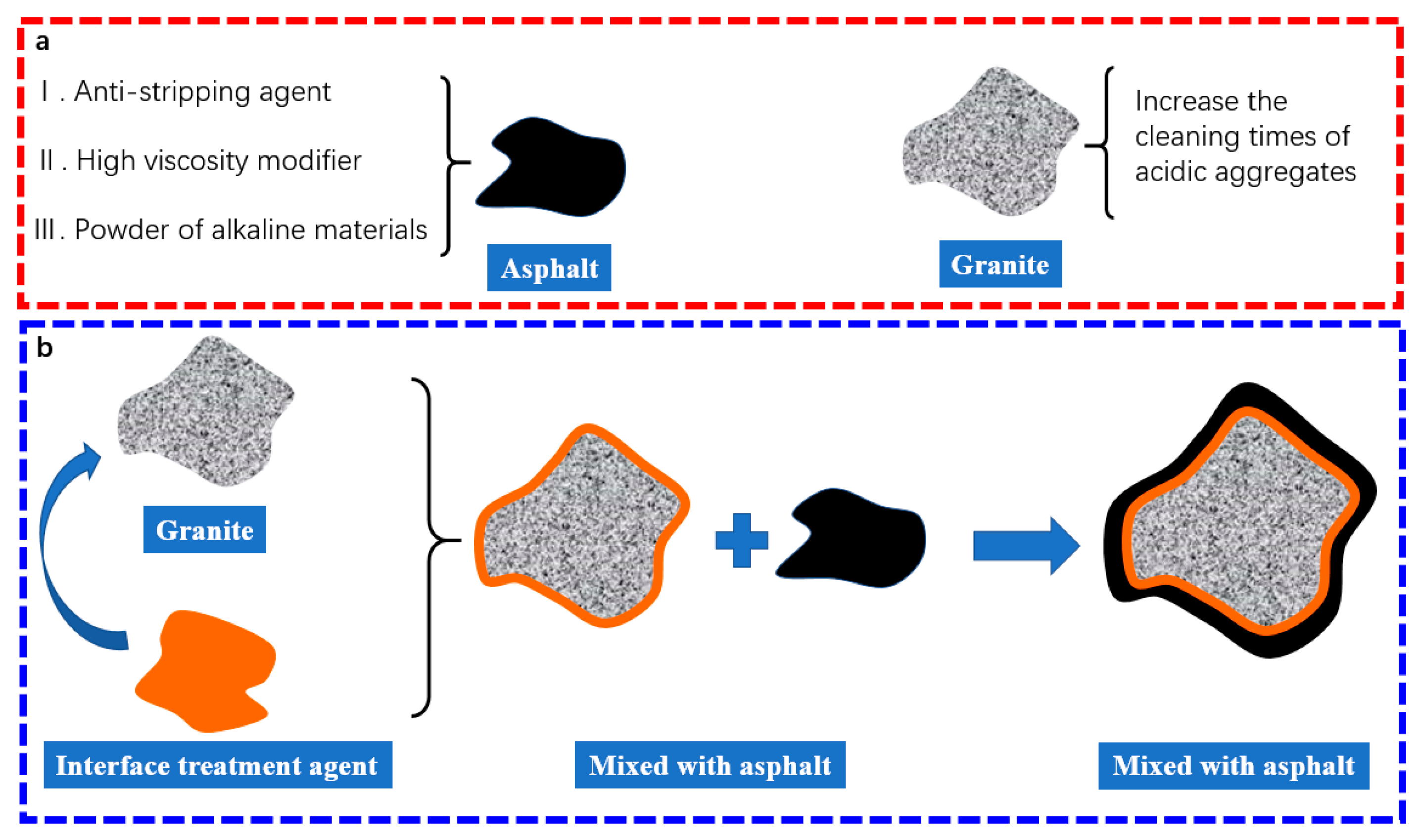
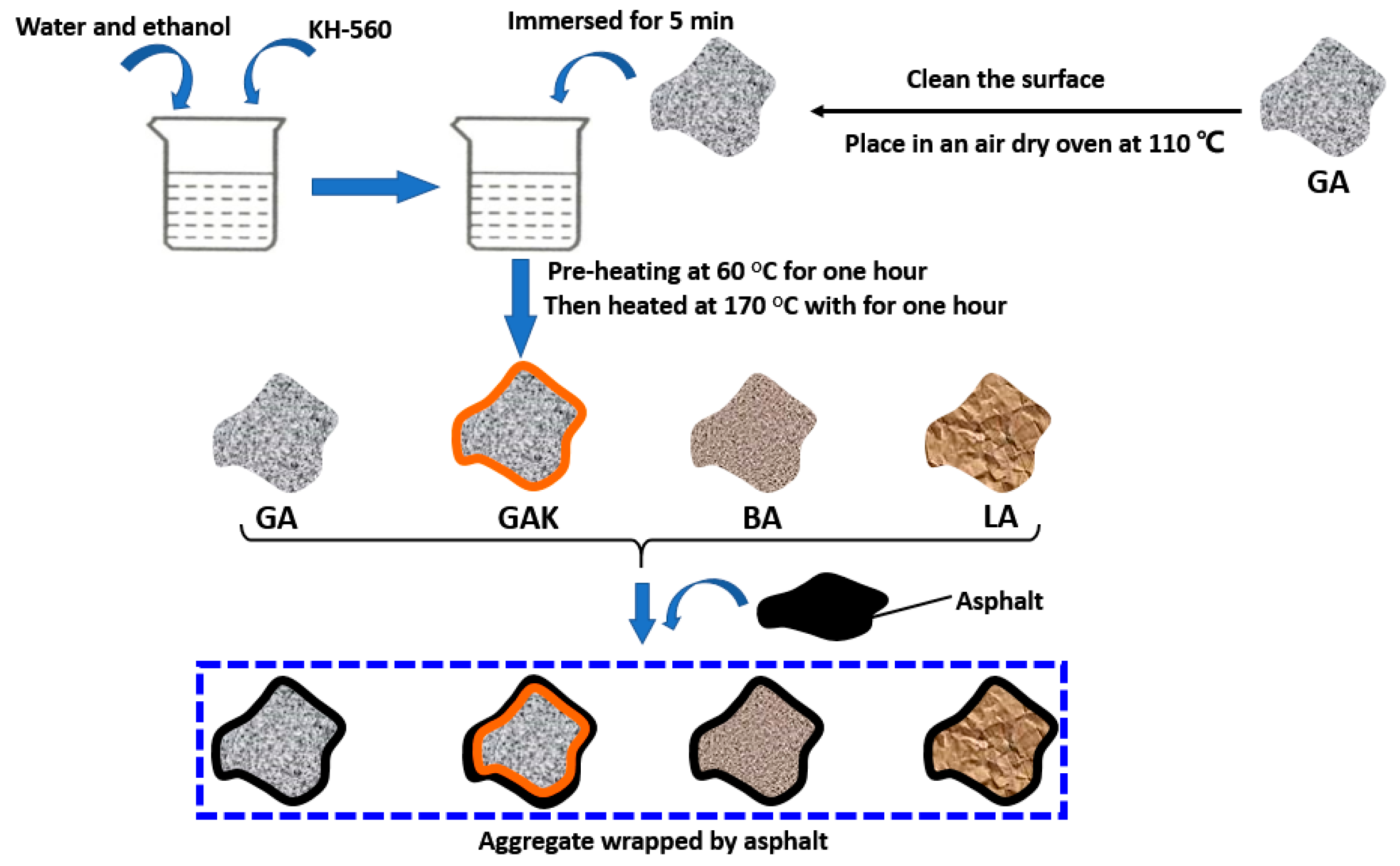
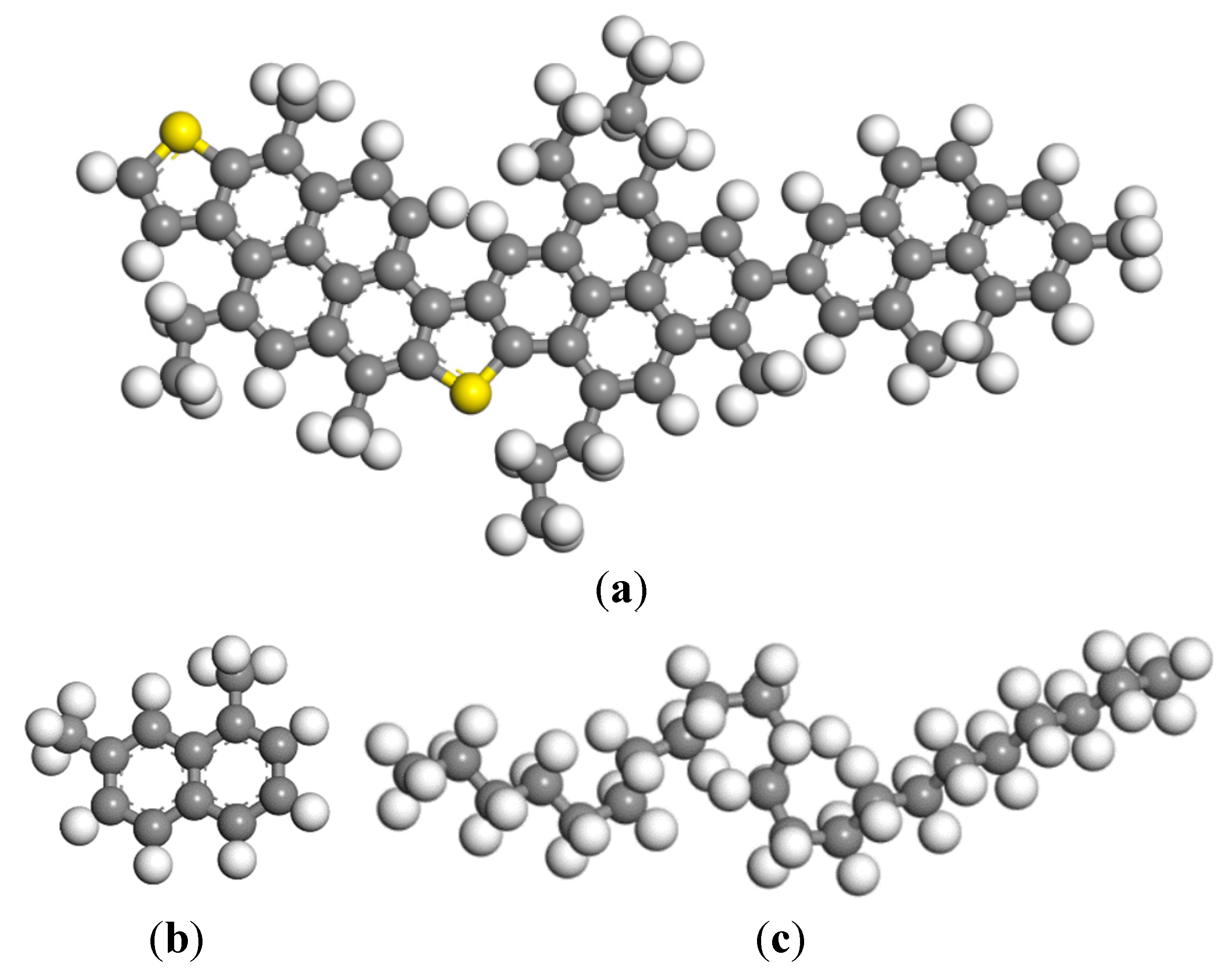

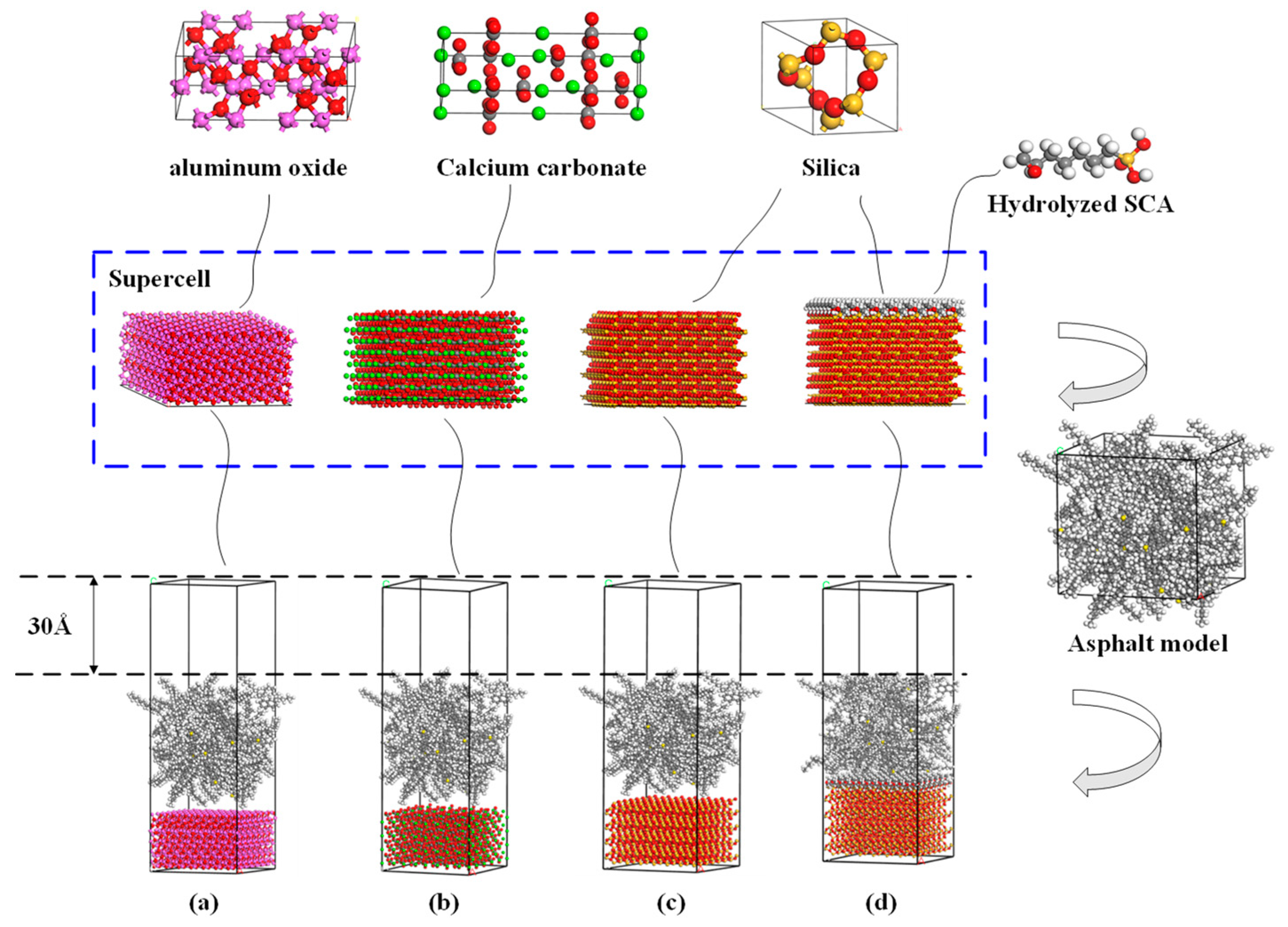
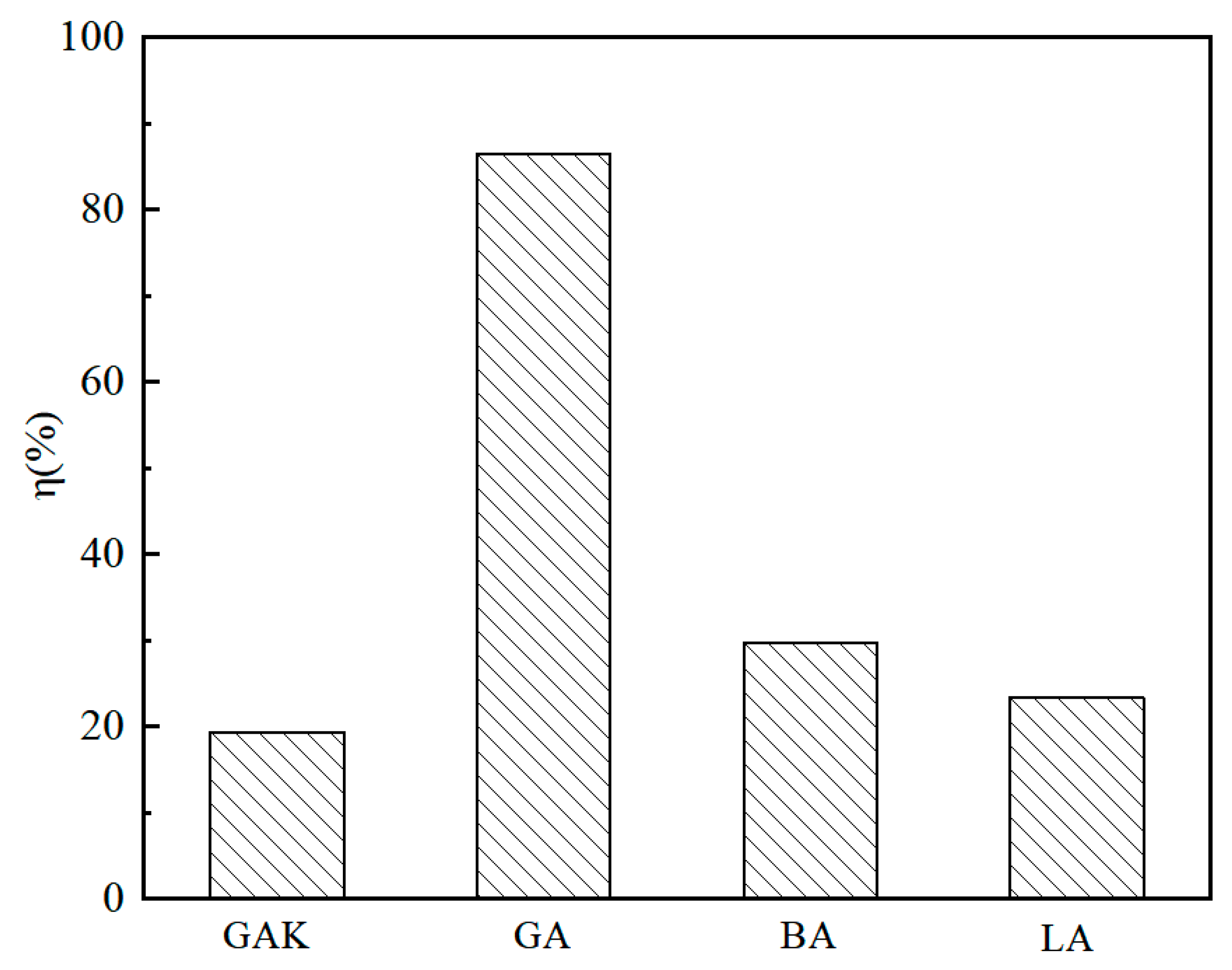
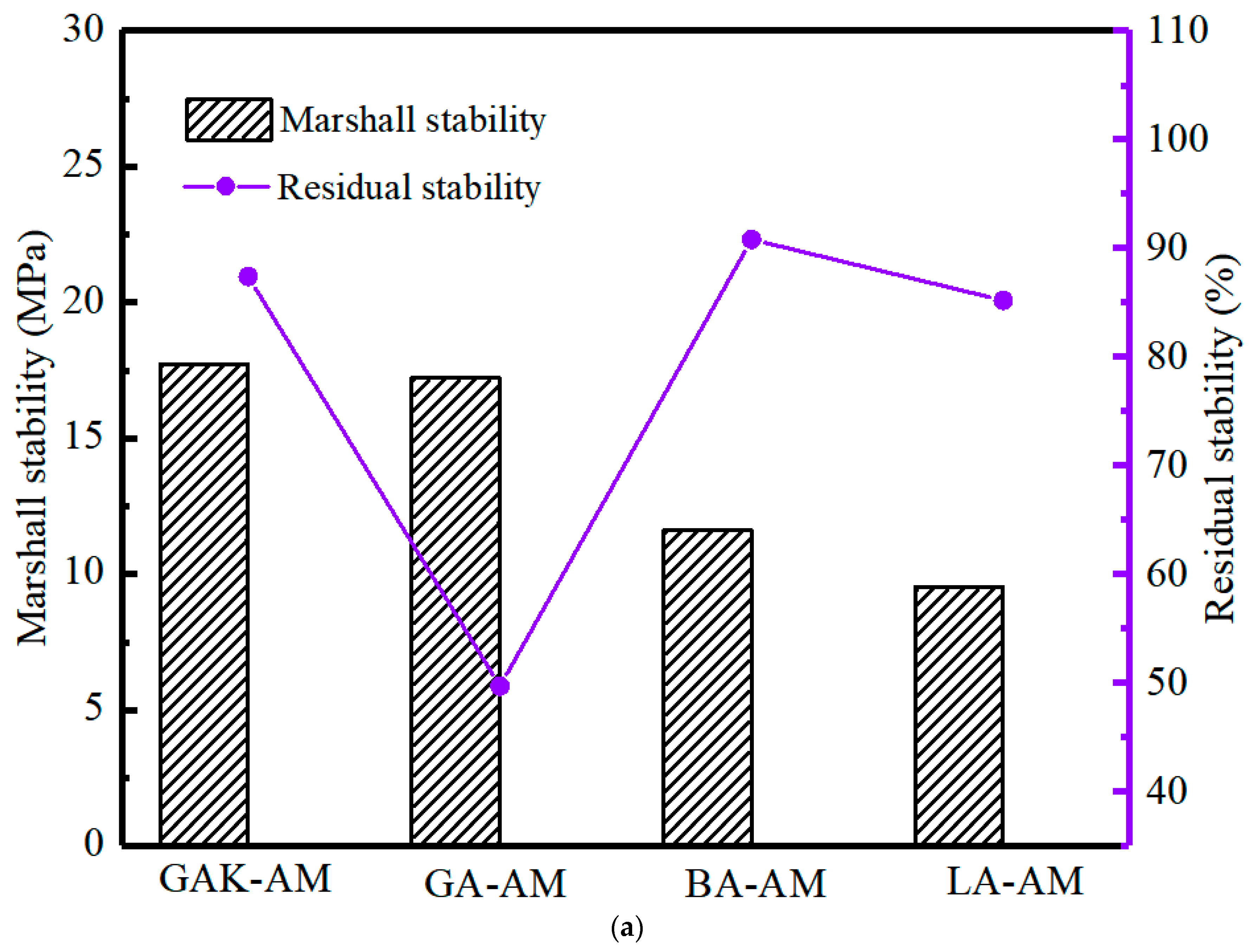
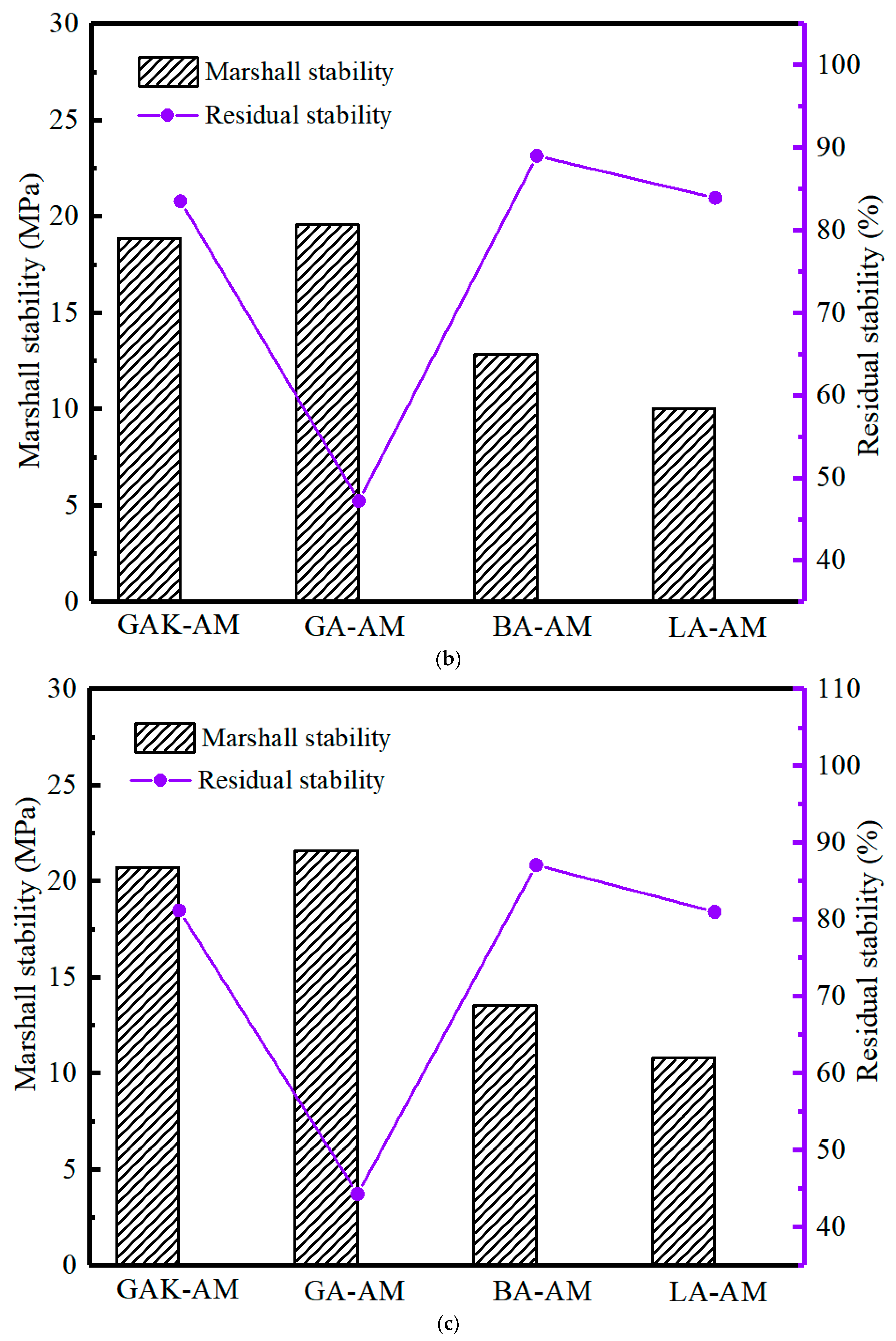

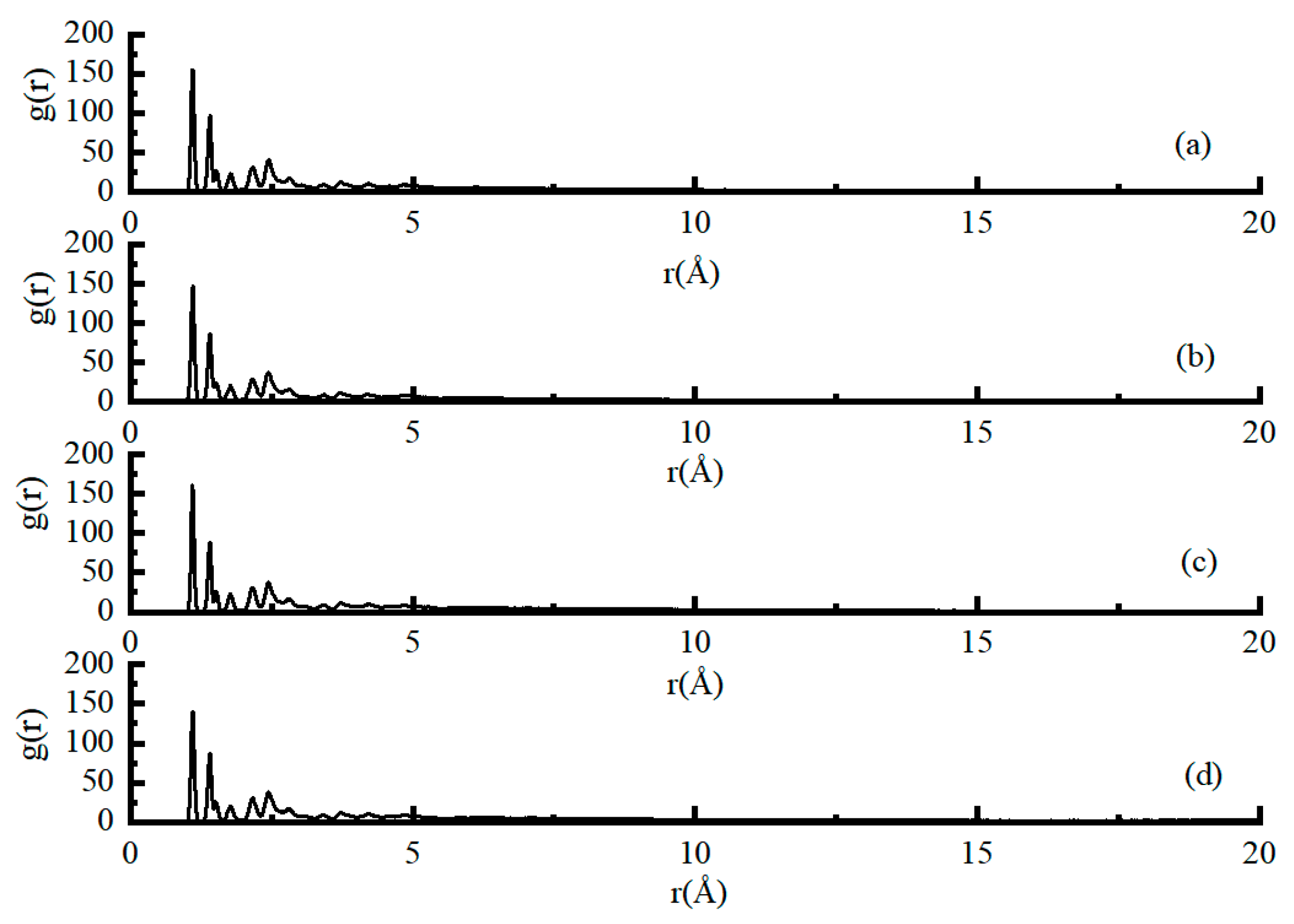

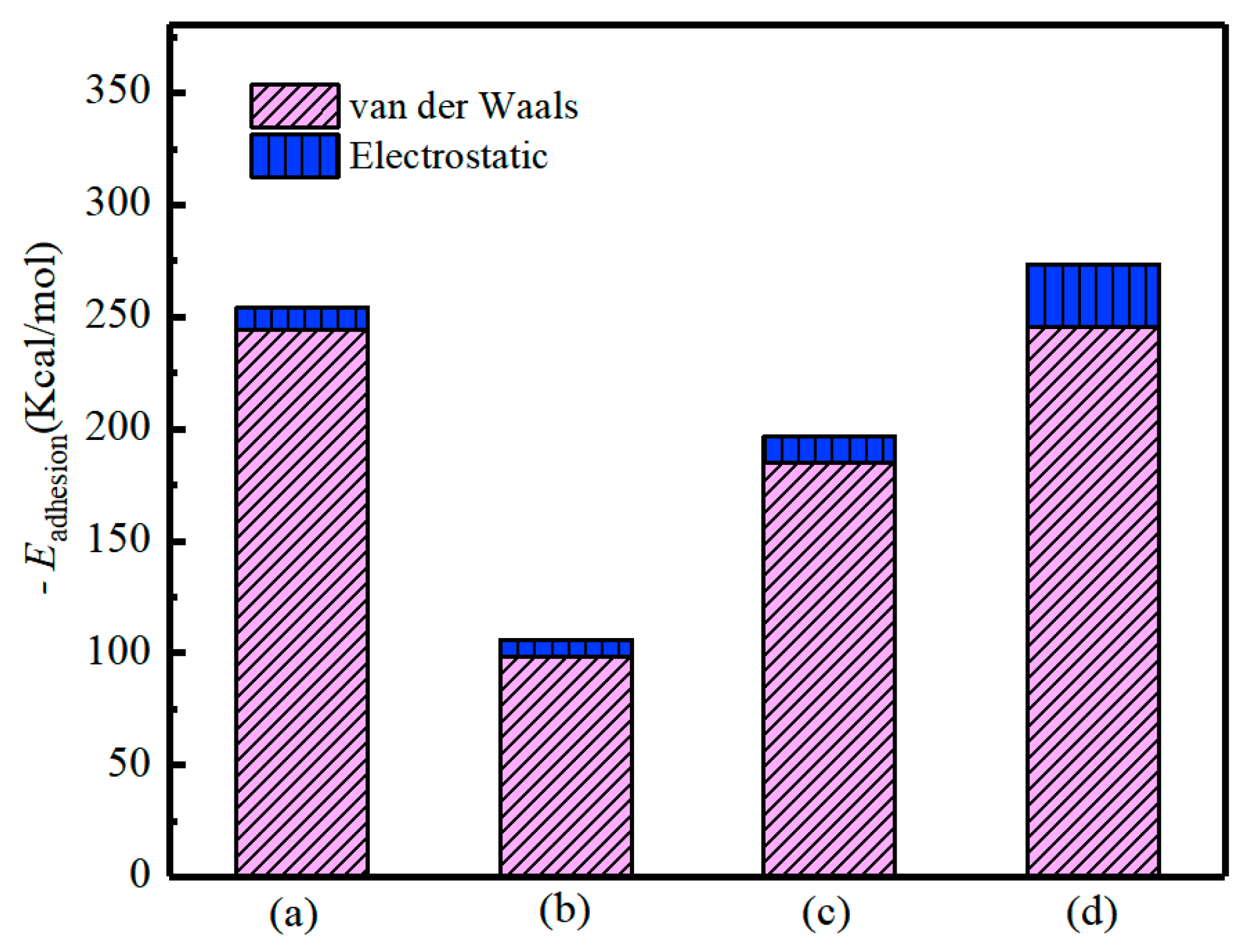
| Parameter | Passing Percentage (%) | |||||||||
|---|---|---|---|---|---|---|---|---|---|---|
| Sieve Size (mm) | 13.2 | 9.5 | 4.75 | 2.36 | 1.18 | 0.6 | 0.3 | 0.15 | 0.075 | |
| Limit of gradation | Upper | 100 | 85 | 68 | 50 | 38 | 28 | 20 | 15 | 8 |
| Lower | 90 | 68 | 38 | 24 | 15 | 10 | 7 | 5 | 4 | |
| Synthetic gradation | GA/GAK | 94.1 | 79.6 | 47.9 | 32.4 | 23.5 | 17.3 | 12.0 | 8.8 | 6.1 |
| BA | 94.9 | 73.4 | 45.6 | 29.5 | 20.1 | 12.7 | 9.1 | 6.8 | 5.9 | |
| LA | 97.5 | 74.7 | 43.2 | 30.1 | 19.8 | 13.0 | 10.1 | 7.4 | 5.5 | |
| Model | Lattice Parameters |
|---|---|
| granite-asphalt | a = b = 33.628 Å, c = 102.932 Å, α = β = γ = 90° |
| granite/SCA-asphalt | a = b = 33.628 Å, c = 90.323 Å, α = β = γ = 90° |
| basalt-asphalt | a = b = 33.089 Å, c = 97.484 Å, α = β = γ = 90° |
| limestone-asphalt | a = b = 32.624 Å, c = 103.277 Å, α = β = γ = 90° |
Publisher’s Note: MDPI stays neutral with regard to jurisdictional claims in published maps and institutional affiliations. |
© 2020 by the authors. Licensee MDPI, Basel, Switzerland. This article is an open access article distributed under the terms and conditions of the Creative Commons Attribution (CC BY) license (http://creativecommons.org/licenses/by/4.0/).
Share and Cite
Ding, G.; Yu, X.; Dong, F.; Ji, Z.; Wang, J. Using Silane Coupling Agent Coating on Acidic Aggregate Surfaces to Enhance the Adhesion between Asphalt and Aggregate: A Molecular Dynamics Simulation. Materials 2020, 13, 5580. https://doi.org/10.3390/ma13235580
Ding G, Yu X, Dong F, Ji Z, Wang J. Using Silane Coupling Agent Coating on Acidic Aggregate Surfaces to Enhance the Adhesion between Asphalt and Aggregate: A Molecular Dynamics Simulation. Materials. 2020; 13(23):5580. https://doi.org/10.3390/ma13235580
Chicago/Turabian StyleDing, Gongying, Xin Yu, Fuqiang Dong, Zezhong Ji, and Junyan Wang. 2020. "Using Silane Coupling Agent Coating on Acidic Aggregate Surfaces to Enhance the Adhesion between Asphalt and Aggregate: A Molecular Dynamics Simulation" Materials 13, no. 23: 5580. https://doi.org/10.3390/ma13235580
APA StyleDing, G., Yu, X., Dong, F., Ji, Z., & Wang, J. (2020). Using Silane Coupling Agent Coating on Acidic Aggregate Surfaces to Enhance the Adhesion between Asphalt and Aggregate: A Molecular Dynamics Simulation. Materials, 13(23), 5580. https://doi.org/10.3390/ma13235580





